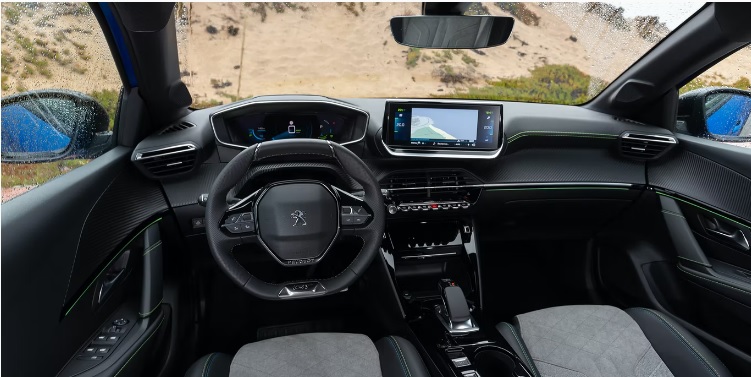Fascinated with the diesel and petrol models of Peugeot e-208, but want to go eco-friendly, now you can get what you desire in the all-new Peugeot e 208. This new drive is a compact car suitable for a small, cute little family perfect for normal day-to-day activities, with a handsome body, cool colors, and a decent price range.
Peugeot E-208 Exterior
This Peugeot e 208 looks very similar to its other siblings – the petrol and diesel models, without any modifications, but is compact enough to accommodate the electric motor and battery pack.
The bonnet is well sculpted with three-claw LED lights, which look like that of a lion’s claw. There is also a prominent rear piano black trim which gives it a very distinctive look. The ‘e’ badging has special features that change lights in different colors lights which makes it distinctive.
There are 18 cells located in its total widthways under the front and rear seats with a total storage capacity of 50kWh. Very few mechanical modifications have been made in comparison to the other two models, the biggest modification is that of the adoption of a 12mm wider rear axle to accommodate the rear cells. The car’s single-speed transmission allows both standard drive and brake mode. The anther big difference is gloss black wheel arch extensions. Overall this EV model is a reasonably handsome one.
Peugeot E-208 Interior
The Interior of Peugeot e 208 is quite compact the seats in the front are spacious and comfortable, though in the rear it is like a bag type not having much space to get comfortable for people with good and big bodies.
The steering wheel arrangement is quite uncomfortable though the screen is very unlikely to be seen clearly with the steering wheel ahead. There is a 7-inch touchscreen infotainment screen with 3D dials which includes DAB radio, Bluetooth, Apple Car Play, and Android Auto too.
Piano key style short buttons are present below the screen which is quite promising. The interiors are quite classy with gloss black and metal brushed finishes. There are plenty of storage spaces.

Peugeot E-208 Engine
The e-208 has a 45 kWh battery that powers a 138bph motor. It can even be driven up to 217 miles on being fully charged which is quite impressive in this kind of EV. It takes only 30 minutes to charge the car from flat zero to 80% using a fast public charge point, otherwise, it might take 7 hrs to charge at home.
The ride is really amazing, as the suspension quality is really good, it can surpass potholes and expansion joints without noticing it. The brakes of Peugeot e 208 are regenerative brakes – which means energy is recaptured during slowing down and is fed back to the battery.
The e-208 is quieter than the other rival cars of its range, it keeps the noise of the wind and the road away from the passengers of the car. The Peugeot is relatively heavier than the standard car, thanks to its power-packed batteries, but compromises its suspensions. It also comes with advanced driver assistance, including clever cruise control that can accelerate, brake, and steer your car for you.
How Safe to Drive
The suspension of the car is quite soft which can be noticeable in the first few rides, but it is taken control by the widened and elongated axle of the car, driven briskly which causes inconvenience slightly. The drive can be a little harder due to the extra weight of the car.
Price of Peugeot E-208
The Peugeot e 208 Active Premium comes for £ 24,800, which comes with heated, electric power folded door mirrors, LED front fog lights, and electrochromic rearview mirrors. The Allure Premium comes for £ 25,795 which has added a 10-inch infotainment system with integrated climate controls and piano key short buttons which are really cool-looking ones.
The GT model which comes with the autonomous driving kit, predominantly the fully-automated parking assistance comes for £30,755, and the topmost model the GT premium comes for £31,592 which has some extra gadgets, gizmos, keyless entry, and heated front seats.
Charging of Peugeot e-208
Within its lineup of conventional superminis, the Peugeot e-208 is the brand’s first all electric vehicle model. Customers have shown a strong preference for the tiny electric vehicle offered by Peugeot. This is likely due to the vehicle’s attractive design, affordable price, ultra-rapid charging capabilities, and generous range of 211 miles. The DS 3 Crossback E-Tense and the Vauxhall Corsa-e are the other two electric vehicles that share a basis with the Peugeot e-208.

The CCS charging standard, which is utilized by the Peugeot e-208 and includes of a combination AC and DC inlet port, is utilized. The Type 2 connector, which is utilized while charging electrical devices at home or at public slow and fast AC points, is located in the upper area of the intake. During quick DC charging via a CCS connector, the lower part that is located beneath the Type 2 input is utilized to transport high power. The location of the CCS inlet on the Peugeot e-208 is on the rear 3/4 panel of the near side, which is typically where a gasoline flap would be located.
Depending on the network and the type of charge unit, the Peugeot e-208 has the capability of receiving a charge that is either slow, quick, or rapid from public charging points. The majority of the time, a 3-pin-to-Type 2 connection is required for slow charging.
While a Type 2-to-Type 2 cable is required for rapid charging. Both of these cables are typically included with the car. The needed CCS connector is permanently attached to the charging device so that rapid charging can take place.
Whether an electric vehicle is being charged with AC or DC current, the driver of the vehicle must first plug the appropriate connectors into the appropriate inlet before the vehicle can “talk” to the charging unit and verify that there is a power supply, that there are no problems, and that it is safe to begin charging. When connected to a charge port in a private residence or place of business, the car will begin the charging process on its own.
In order to begin charging on a public charger, an activation procedure must first be completed. It is possible that in order to do this, you will need to make use of an RFID card or a smartphone app, both of which will typically be linked to an account that has been established in advance. Newer units increasingly come equipped with contactless pay-as-you-go options for customers. After they have been activated, the units will do additional checks on the connection and the account before beginning to charge the car.
How long does it take for a Peugeot e-208 to get fully charged?
The table that follows provides an estimate of how much time it will take to fully charge a Peugeot e-208. Times are for a full charge of one hundred percent, with the exception of rapid charging, which is quoted at the more typical range of zero to eighty percent. This is because the majority of rapid chargers reduce power before reaching one hundred percent charge in order to protect the battery and maximize efficiency.

It is important to keep in mind that the times that are displayed are simply a reference, as it is quite rare for an electric vehicle to require a complete charge from 0%.
The ambient temperature, the energy loads inside the vehicle, any upper and lower charge restrictions designed to lengthen the battery’s life and protect it from potential damage, and the fact that charging rates slow down once the maximum charge is reached are some of the additional factors that could cause the charging time to vary.
In addition to its rapid charging capacity of 100 kW DC, the Peugeot e-208 comes standard with an on-board charger with a capacity of 7 kW for charging via Type 2 AC. This implies that even when connected to a fast charger with a rated output higher than 7 kW.
The Peugeot e-208 will only be able to charge at a rate of 7 kW even though the fast charger’s output rating is higher. On the other hand, there is an option for an on-board AC charger with 11 kW of charging capacity, which would raise the charging limit to 11 kW and reduce the amount of time needed to charge at public charge points with 11 kW and 22 kW of capacity.
You can determine how long it will take to charge a Peugeot e-208 by using the Home Charging Calculator on Zap-Map. For more precise results, the amount of charge that is stored in the battery, the speed at which the connectors can be connected, and the on-board charger options can all be customized.
At home, the process of charging an E-208 Peugeot?
Charging an electric vehicle (EV) at one’s residence is frequently the most time- and labor-efficient way to do it. There are financial incentives offered by the government for the installation of electric vehicle (EV) charging stations in private homes, and a great number of businesses offer EV charging stations that have been completely installed for a predetermined fee.
The majority of home chargers have a rating of either 3 kW or 7 kW. Wall-mounted charging stations with higher power often cost more than the 3 kW option, but they cut the amount of time needed to fully charge an electric vehicle in half.
Many manufacturers of plug-in cars have agreements or relationships with companies that supply charge points, and in some cases, they include the installation of a free home charge station with the purchase of a new vehicle. Despite this, Zap-Map suggests doing some research beforehand because there are a number of options available for purchase that are suited.
The Three Most Important features of Peugeot e 208
- 50 kWh battery – which comes with 8 years of guarantee of the battery, for its charging capacity and 80% charge within 30 minutes.
- About 211 of WLTP range.
- 7-inch infotainment screen with piano-like buttons.














